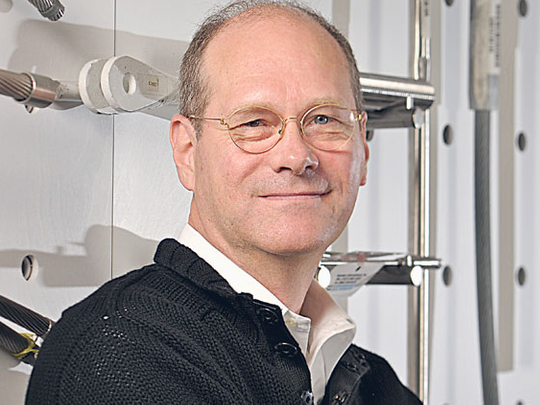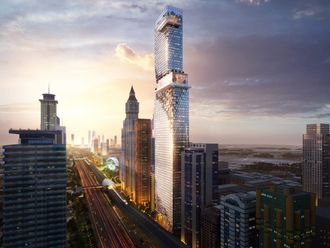
As the Burj Khalifa is prepared for a spectacular opening on January 4, its builders will hark back to the difficult structural engineering challenges that they had to address and resolve to complete the super-tall project.
"This is a first-of-its-kind project in the world and we are excited and proud to be part of history. This is a project that people from all over the world will really appreciate," says George J. Efstathiou, Managing Partner of Skidmore, Owings & Merrill (SOM), the project design and structural engineering contractor of Burj Dubai.
Designing the Burj was an evolving experience, adds Bill Baker, chief structural engineer of Burj Khalifa and partner in charge of structural and civil engineering for the Chicago and London offices of SOM.
Their initial goal was to design the world's tallest building that would be just a bit taller than Taipei 101, the previous tallest structure. They eventually ended up surpassing the world's tallest tower by a considerable margin.
"As engineers, it was fairly exciting to achieve things beyond what we initially thought were not possible," says Baker, the guy at SOM who makes sure that the quality, innovation, material economy, and cost efficiency are customised to fit each project's scope and needs. "The client wanted us to keep going higher and higher. So the new challenge was to see how high we could go."
For the Burj Khalifa project, the SOM team consisted of more than 65 people, including architects, structural and MEP engineers, and administration personnel.
Origins
"I was involved from the very beginning. Actually, I went to the interview with the developer back in March 2003," Baker tells Gulf News. "With the rest of the design team, the architects and the mechanical engineers, we worked on how to put this building together, how it should be made and how it should be shaped. My team coordinated with the other teams so that all the pipes fit, all the plumbing fits, the electrical connections fit and all the other things fit. We had a very long series of intense coordination."
Baker added that there was no "one" biggest challenge in implementing the project. What they had was a series of challenges.
"Basically, the first four years were the most intense while the designing started in early 2007," recalls Baker. "Also, understanding how it could be efficiently and economically built was a challenge."
Another major challenge was understanding the wind and how the building reacted to it. SOM did a series of testing in coordination with different architects, engineers and consultants. For a building of this height and slenderness, wind forces and the resulting motions in the upper levels become dominant factors in the structural design.
Wind tunnel programme
An extensive programme of wind tunnel tests and other studies were undertaken under the direction of Dr Peter Irvin of Rowan William Davies and Irwin's (RWDI) boundary layer wind tunnels in Guelph, Ontario.
"Early in the project, we thought we would allow for a damper if one needed to be built; so we set a cross at an area at the top of the building where we could put a damper, but it looks like we don't need it because we are comfortably below the criteria. The numbers are so low that movement may not be perceptible at all, even in a big storm," says Baker.
A damper is essentially a device that helps buildings withstand the force exerted by the wind or by seismic activity.
Among other things, the wind tunnel programme helped determine the impact of the different forces acting on the building, simulated the dynamic behaviour of the building, measured localised pressures, and established a statistical model of the wind climate for the project area.
The Burj Khalifa's foundation is not very different from much smaller conventional buildings. The way the tower spreads as it nears its base spreads the load over a larger area.
Design-wise, Burj Khalifa is just one large, extruded structure that has been trimmed to form its shape.
To support the unprecedented height of the building, the engineers developed a new structural system called the ‘buttressed core', which consists of a hexagonal core reinforced by three buttresses that form the ‘Y' shape. This structural system enables the building to support itself laterally and keeps it from twisting.
Burj Khalifa is expected to hold up to 35,000 people at any given time. Since current elevator technology would not permit a single elevator to travel the entire height of the building, the only means of serving all floors of this structure was to design a transfer system, connecting elevators serving separate sections of the building.
Elevator system
The building utilises high-speed, non-stop shuttle elevators bringing passengers to sky lobby floors where they transfer to local elevators serving the floors in between.
Burj Khalifa will have 58 elevators and 8 escalators, which include 20 Gen2 flat belt elevators and two double deck observation deck cabs with a capacity for 12-14 people per cab.
Travelling at 10 metres per second, they will have the world's longest travel distance from lowest to highest stop. The building service/fireman's elevator will have a capacity of 5,500 kilograms and will be the world's tallest service elevator.
Burj Khalifa will also be the first high-rise building to contain controlled evacuation elevators for emergency situations. The tallest tower in the world will also have the world's highest elevator installation — The spire maintenance elevator — situated inside a rod at the very top of the building.
Water system
The Burj Khalifa's water system will supply an average of about 946,000 litres of water per day. At the peak cooling times, the tower will require approximately 10,000 tonnes of cooling per hour, which is equivalent to the capacity provided by 10,000 tonnes (22.4 million lbs or 10.2 million kg) of melting ice in one day.
The tower will also have a condensate collection system, which will use the hot and humid outside air, combined with the cooling requirements of the building and will result in a significant amount of condensation of moisture from the air.
The condensed water will be collected and drained into a holding tank located in the basement car park.
This water will then be pumped into the site irrigation system for use on the tower's landscape plantings. This system will provide about 15 million gallons of supplemental water per year, equivalent to nearly 20 Olympic-sized swimming pools.
Interiors
On the architectural concept and interiors of Burj Khalifa, Baker said that the building's design incorporates cultural and historical elements particular to the region. The Y-shaped plan is ideal for residential and hotel usage, with the wings allowing maximum outward views and inward natural light, he added.
The design of the Burj Khalifa is derived from the geometries of the desert flower and the patterning systems embodied in Islamic architecture.
When asked about how he thinks the public will react to the architectural work Baker said: "Once the Burj Khalifa is completely cleaned on the outside and the stainless steel and the glass catches the light, it will look like a torch in certain times of the day. It's very majestic."
Local influences
"We knew that the people who will be occupying this building will be coming from all over the world. So we needed to come up with a design and an approach that would be appealing to a broad range of tastes," says Nada Andric, Project Interiors Designer and Associate Director at SOM.
In addition, we had to consider the geometry of the building and the influences of the local, regional culture."
Andric said that they drew a lot of inspiration from the elements that are important to Dubai. Water is a recurring element in the interiors; right at the entry lobby, a pool has been built with a bridge that leads to interior lobby where another water-themed element is introduced - a fountain.
"This being the premier residence of people from all over the world, we also felt that the materials we use for the designs must exude quality and luxury," said Andric, adding that they have sourced around four to five very precious materials that were used in the interiors of the building.











